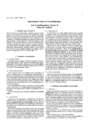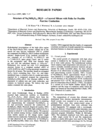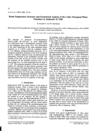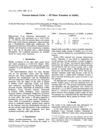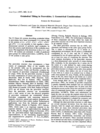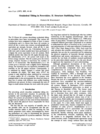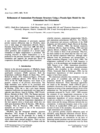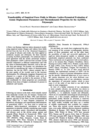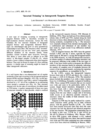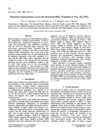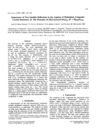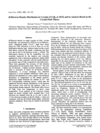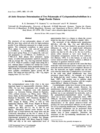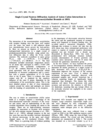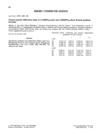issue contents
February 1997 issue

Cover illustration: Contoured distribution of hydrogen bonds from N-H and O-H donors about the oxygen acceptors of the disulfate dianion. Data for the 232 hydrogen bonds (O...H > 2.62 Å) were computed from the Cambridge Structural Database and the required symmetry was applied to generate the final distribution. Courtesy of M. Verdonk and J. Cole
international union of crystallography
Free 

research papers
Download citation


Download citation


The structure of Na3NdSi6O15.2H2O, a compound previously and erroneously reported as NaNdSi6O13(OH)2.nH2O, is described. Channels likely to serve as pathways for easy ion transport are identified.
Download citation


Download citation


From the structure refinement of dodecasil 3C, it follows that the deformation from the ideal cubic to the tetragonal structure is mainly related to (i) a local tilt system and (ii) tetragonal tetrahedral distortion.
CCDC reference: 131618
Download citation


Download citation


The pressure-induced phase transition and the subsequent structural changes in NaSbF6 are described by means of a sphere-packing deformation which is superimposed by cation–cation repulsions.
The 23 Glazer tilt systems which describe octahedral tilting distortions in perovskites are examined. Unavoidable distortions of the octahedra and cation ordering are considered.
The 23 Glazer tilt systems which describe octahedral tilting distortions in perovskites are examined. The forces which stabilize each tilt system are explored.
Download citation


Download citation


The structure of a new quaternary phosphosulfide, Ag2Ti2P2S11, is determined from single crystal X-ray diffraction data. The structure is analysed and the temperature dependence of the silver atomic displacement parameters is studied by means of a Gram–Charlier anharmonic development of the atomic displacement factor. It is shown that the Ag distribution is primarily static in nature.
Download citation


Download citation


The structure of ND4ReO4, assuming two ammonium ion orientations with variable occupancy, has been determined by Rietveld refinement using previously published powder neutron diffraction data. The resulting ammonium ion orientations and occupancies are in good agreement with pseudo-spin theory.
Download citation


Download citation


Atomic displacement parameters, Raman and IR spectra have been calculated by lattice dynamics for aluminium silicates Al2OSiO4 (andalusite and kyanite).
A new type of twinning is described, revealed by high-resolution electron microscopy. Across the twin boundary the two intergrown structure elements are interchanged and the structure is thus `inverted' and in general the two `twin' parts represent different members of the intergrowth family.
Download citation


Download citation


Microscopic distortion patterns associated with a structural phase transition in (Cu1-xZnx)WO4 have been measured using Rietveld analysis of neutron powder diffraction data. It is clearly demonstrated that the transition driving force is the Jahn–Teller effect on the Cu2+ cations.
The composite, incommensurately modulated structure of [M2Cu2O3]7+δ[CuO2]10, M = Bi0.06Sr0.46Ca0.48 and δ = 0.03 has been refined against 603 main reflections, 428 first-order and 64 second-order satellite reflections. Special problems relating to synchrotron radiation experiments are discussed. It is shown that the inclusion of true satellite reflections in the refinement is necessary to avoid large correlations between thermal displacement parameters and modulation displacement parameters, and thus to obtain a physically reasonable model.
The four-dimensional, composite, incommensurately modulated structure of [(Bi0.04Sr0.96)2Cu2O3]7[CuO2]10 has been determined. Refinements have been based on 549 main reflections, 442 first-order and 183 second-order satellite reflections. The structure is compared with a previously published model and those of the BiSrCaCu oxide superconductors and the structural chemistry is discussed.
Download citation


Download citation


Powder neutron diffraction and low-temperature single-crystal X-ray diffraction are used to re-investigate the room-temperature phase of PbZrO3. Evidence is given to show that the oxygen substructure is ordered and forms regular ZrO6 octahedra.
Download citation


Download citation


The electron density distibution in CeB6 crystals was measured at 165 K by X-ray diffraction using the relativistic scattering factors for Ce, avoiding the multipole diffraction effect and selecting ω and χ angles of the four-circle diffractometer, at which the temperature of the sample was stable. The analysis based on crystal field theory confirmed that the large peaks on the deformation density map around the Ce atom approximate the Ce 4f-electrons on the t1u-orbitals.
The different FWHM distributions of the Bragg reflections are used to dissect the powder pattern of cyclopentadienylrubidium (RbCp) into the contributions of two polymorphs. Both phases, which could be solved ab initio from a single powder pattern, are found to be composed of polymeric zigzag chains.
Download citation


Download citation


This paper reports the isothermal compressibility and the pressure dependence of the crystal structures of the superconducting charge-transfer salt κ-(BEDT-TTF)2Cu(NCS)2.
Tris(5-acetyl-3-thienyl)methane is a rare example of a host molecule which has many potential conformers. Analysis of the substantial but still incomplete database of published crystal structures suggests that each group of isomorphous crystals contains only one sort of conformer, but a variety of guests. A mechanism is proposed by which the inclusion complexes are formed.
Download citation


Download citation


Pulsed neutron diffraction is used to investigate cation–anion hydrogen-bond interactions in a single crystal of perdeuteroacetylcholine bromide. The pyramidal configuration of C—O⋯Br− contacts is in good agreement with ab initio molecular orbital predictions.
CCDC reference: 131614
Download citation


Download citation


Charge density studies of E-tetraethyl-1,4-diammoniumbut-2-ene.2PF6 show that the electrostatic potential is positive at all points on the surface of the cation, which is used as an antifungal agent.
CCDC reference: 131615
short communications
Correction to Acta Cryst. (1996). B52, 896-898.


 journal menu
journal menu








